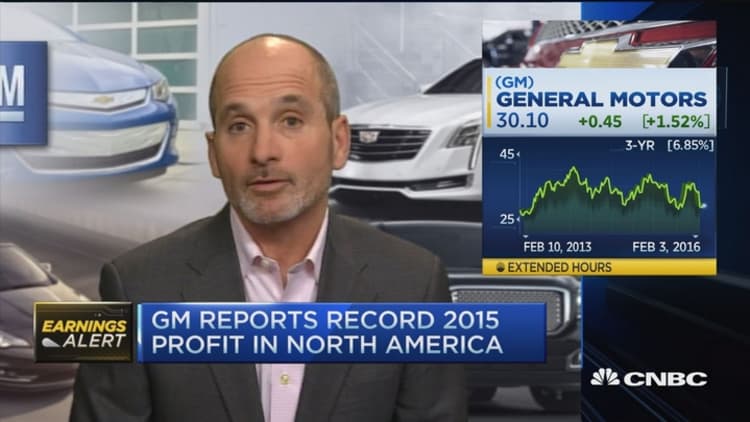
Despite record profits, strong profit margins and sales that show no sign of slowing down, auto stocks are tumbling.
Take a look at the Big 3 automakers. So far this year, shares of Fiat Chrysler are down 28 percent, Ford's stock is down 20 percent, and shares of General Motors have fallen 15 percent.
GM's shares continued their slide on Wednesday, even as the automaker handily topped earnings expectations for the fourth quarter, and wrapped up its most profitable year ever in North America.
Following the report, GM CFO Chuck Stevens tried to calm investors' concerns that the automaker's performance has peaked, telling CNBC that "this is not as good as it gets for General Motors."
"We have talked about 2016 having improved earnings, improved margins, improved cash flow and improved earnings per share," Stevens said.
Indeed, GM raised its 2016 guidance just a few weeks ago. And across the broader industry, the year started off with better-than-expected sales in January.
Despite this momentum, here are three reasons why investors are steering clear of the auto sector.
1. Rising inventories
For those concerned that the economy is slowing down, and that auto plants that have been running hot will build too many vehicles, January's inventory numbers from some automakers are troubling.
Ford has a 104-day supply, which is slightly above its 10-year historical average of 96 days, according to JPMorgan.
Though Ford called the inventory build normal for this time of year, RBC Capital analyst Joe Spak summarized the concern among investors, writing, "The market will now be on the lookout for possible production cuts. We retain a cautious view."
2. Higher incentives
Incentives in January jumped 15.6 percent from last year, to an average of $2,992, according to JPMorgan.
So while the money automakers are spending to sell vehicles is down slightly from December, this year-over-year jump in incentives has some investors wondering if the industry will repeat its past mistake of pumping up discounts to prop up sales, thereby hurting profitability.
In a research note, JPMorgan analyst Ryan Brinkman acknowledged the incentives, but added, "Overall, we would rate the health of the U.S. auto industry as 'strong.'"
3. Concern that sales have topped, recession is looming
This is the big fear among investors. With auto sales hitting a record 17.5 million in the U.S. last year, and amid expectations they will grow just 1 to 1.5 percent in 2016, many are questioning whether sales have hit a ceiling.
Even industry veterans admit sales may not go much higher, though they've predicted figures will likely plateau, not plunge. GM's Stevens said there's no indication industry sales will slow.
"We don't subscribe to the view that there is a downturn imminent," he said. "The industry fundamentals, the economic fundamentals would support [strength in the U.S.] and we are not alone in this view."
So while relatively strong job growth, high consumer confidence and low oil are all reasons to believe auto sales and profits will not only remain strong — but could even grow — investors have made it clear they are worried.
Is it rational?
Maybe not. But in this market it doesn't take much to scare investors.
Questions? Comments? BehindTheWheel@cnbc.com.





